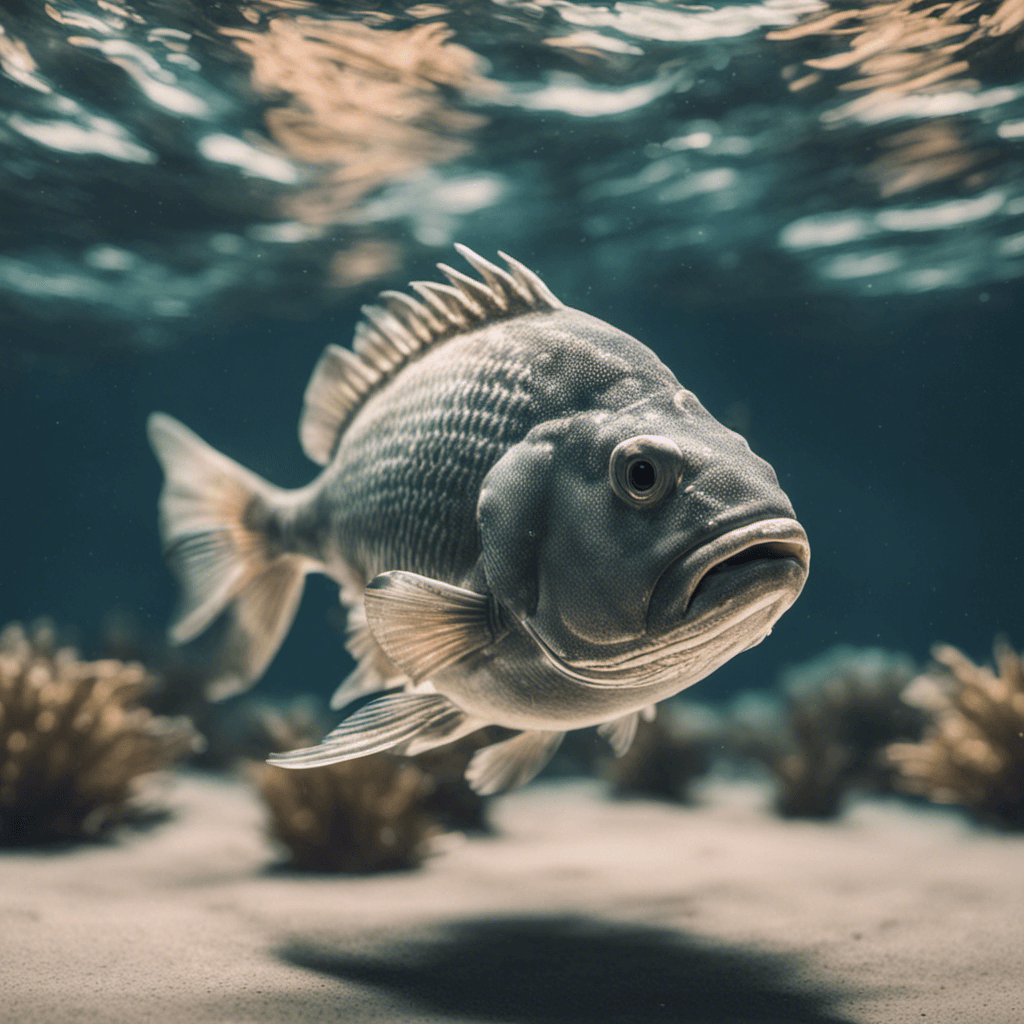You think you’re ready for the thrill of inshore game fishing? Well, get ready to be hooked!
With tarpon as your guide, you’ll look into a world of marsh cruisers, coastal ambushers, estuarine predators, and powerhouse pursuers.
This article will equip you with the know-how to reel in these prime game fish, while adhering to local regulations and seasonal tips.
So, grab your gear and prepare for an unforgettable inshore experience.
Are you ready for the thrill of inshore game fishing? Well, get ready to get hooked! Let tarpon be your guide and dive into a world of marsh cruisers, coastal ambushers, estuarine predators, and powerhouse pursuers. This article will give you the know-how to reel in these prime game fish, all while following local regulations and seasonal tips. So, grab your gear and get ready for an unforgettable inshore experience.
- Key Takeaways
- Introduction: The Thrill of Inshore Game Fishing
- Redfish (Red Drum): The Marsh Cruiser
- Snook: The Coastal Ambusher
- Speckled Trout (Spotted Seatrout): The Estuarine Predator
- Jack Crevalle: The Powerhouse Pursuer
- Ladyfish: The Silver Acrobat
- Black Drum: The Subtle Giant
- Mangrove Snapper: The Stealthy Biter
- Habitats Explored: Where to Find Your Inshore Game
- Diet Insights: What Attracts Our Inshore Species
- Understanding Fish Behavior: Predicting the Bite
- Fishing Techniques: Mastering the Inshore Catch
- Co-targeting with Tarpon: Two Birds, One Stone
- Tackle and Gear Recommendations for Inshore Fishing
- Conservation Spotlight: Protecting Our Inshore Habitats
- Catch and Release: Ensuring Sustainable Fishing
- Local Regulations: Fishing Responsibly
- Seasonal Tips: Best Times for Each Species
- Rewritten:
- Conclusion: Embracing the Inshore Experience
- Further Reading: Dive Deeper into Inshore Fishing
- Frequently Asked Questions
- Conclusion
Key Takeaways
- Tarpon are a prime inshore game fish species.
- They migrate along coastlines during the summer.
- Live bait such as mullet or crabs can be used to target tarpon.
- Techniques like sight casting or drift fishing near bridges and passes are effective for tarpon fishing.
Introduction: The Thrill of Inshore Game Fishing
Are you ready to experience the thrill of inshore game fishing?
Inshore game fishing offers a unique and exciting opportunity to catch a variety of species in diverse habitats. The success of your fishing expedition depends on understanding the habitat diversity, selecting the right bait, using effective fishing techniques, and having the appropriate gear.
Inshore habitats include marshes, estuaries, and shallow coastal waters, which are home to a wide range of game fish such as tarpon, redfish, snook, and trout. Bait selection is crucial, as different species have specific preferences. Fishing techniques vary depending on the target species and the habitat. It’s recommended to use light to medium tackle, including spinning or baitcasting reels, with appropriate line strength.
Conservation efforts are essential to preserve these habitats and sustain the game fish populations.
Now, let’s look into the world of redfish (red drum): the marsh cruiser.
Redfish (Red Drum): The Marsh Cruiser
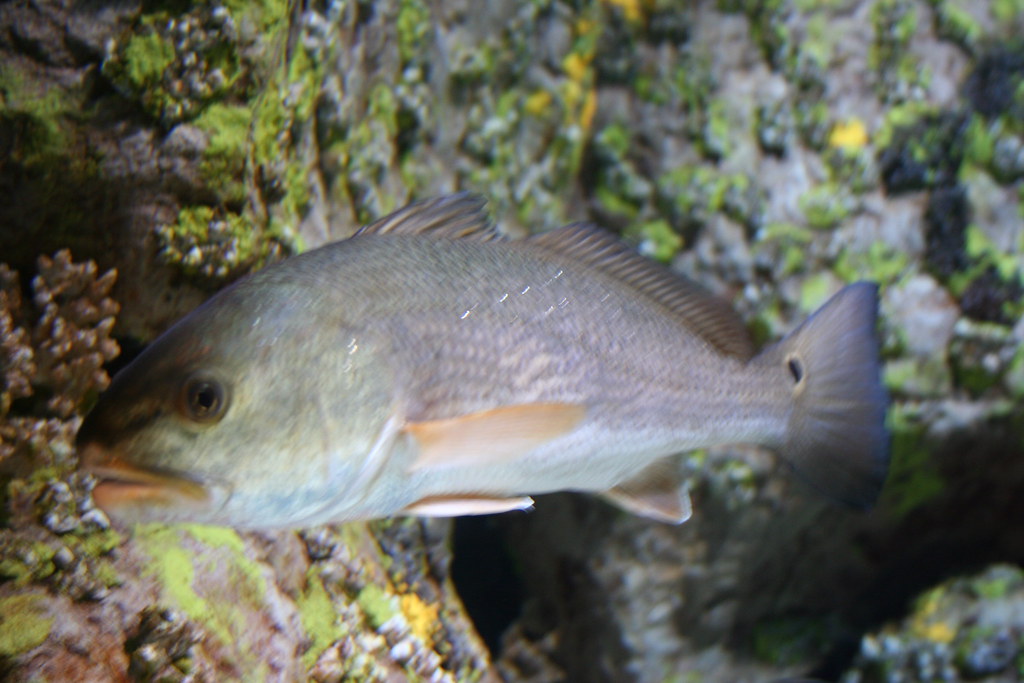
You will be amazed by the skills of redfish (red drum) as they effortlessly navigate through the marshes. Marsh fishing for red drum is a thrilling and popular activity for anglers who enjoy inshore game fishing. Redfish are well-known for their unique behavior and ability to adapt to different environments. They have a strong sense of smell and can detect prey from a distance.
Red drum can typically be found in prime inshore locations like marshes, flats, and estuaries. In these areas, they feed on crustaceans, baitfish, and other small organisms. To effectively target redfish, it is important to understand their behavior and use appropriate techniques such as sight fishing and casting near structures.
Anglers frequently employ live bait, lures, or flies to attract these strong and hard-to-find fish. Red drum, with their capability to maneuver through marshes and their behavioral patterns, present an exhilarating and demanding challenge in the realm of inshore game fishing.
Snook: The Coastal Ambusher
While exploring the coastal waters, it is important to be cautious of snook. These sneaky predators patiently wait for the perfect moment to ambush their prey. Not only are they fascinating to observe, but they also play a crucial role in the ecosystem.
To understand snook better, here are three key points:
- Snook behavior is fascinating. These fish are experts at staying hidden, thanks to their incredible camouflage. They have the remarkable ability to blend seamlessly with their surroundings. Snook often choose to hide near structures such as mangroves, docks, or rock formations. They patiently wait for their prey to come close enough for them to strike.
- Snook Diet: Snook are opportunistic eaters with a diverse diet. While they primarily feed on small fish like mullet, sardines, and shrimp, they are also known to consume crabs, small crustaceans, and even insects.
- Snook have an opportunistic diet that includes a variety of foods. Their primary food sources are small fish such as mullet, sardines, and shrimp. However, they are also known to eat crabs, small crustaceans, and even insects.
- Snook fishing techniques involve using live bait such as pilchards or pinfish, which imitate the snook’s natural prey. Anglers can also opt for artificial lures like topwater plugs or soft plastic jigs, which can be equally effective. However, it is important to accurately cast these baits near the snook’s habitat in order to entice a bite.
Understanding these aspects of snook behavior, diet, and fishing techniques will enhance your experience while exploring the coastal waters.
Speckled Trout (Spotted Seatrout): The Estuarine Predator
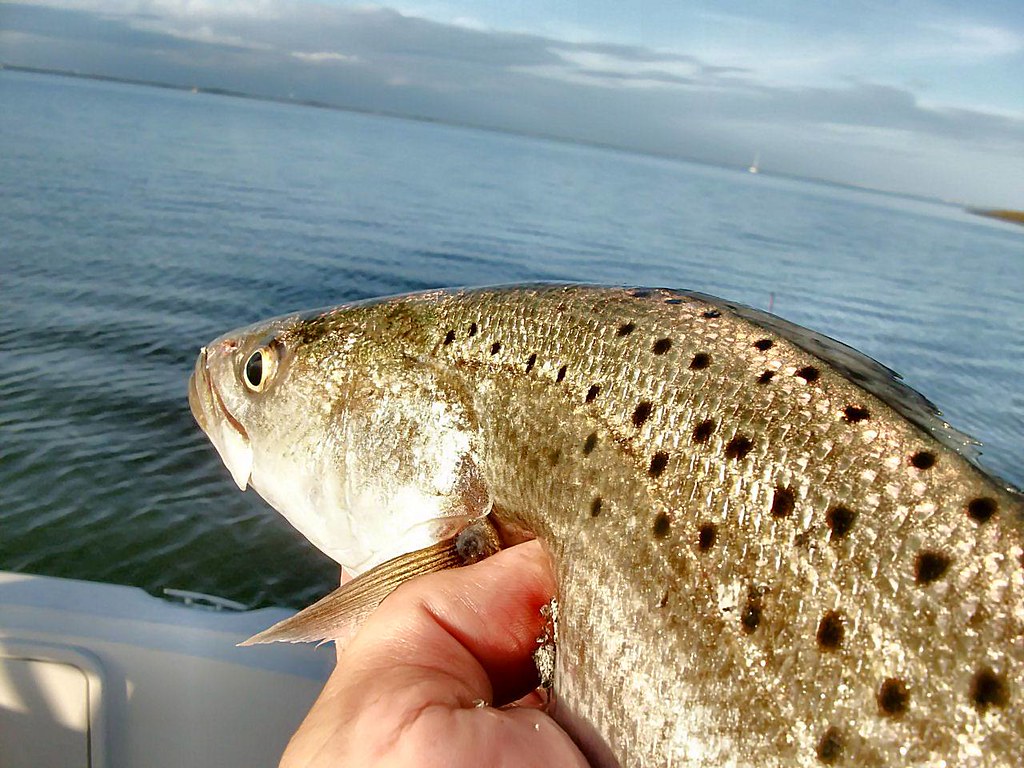
If you’re targeting speckled trout, cast your lure near grass beds or oyster bars, and reel it in slowly to entice a strike.
Speckled trout, also known as spotted seatrout, are voracious predators that inhabit estuarine environments along the Gulf of Mexico and the Atlantic coast. They primarily feed on a variety of estuarine prey, including shrimp, crabs, and small fish.
Speckled trout employ various hunting techniques to capture their prey, such as ambushing from grass beds or oyster bars and using their sharp teeth to seize their victims. Their breeding habits involve spawning during the warmer months in shallow, grassy areas.
However, speckled trout populations have experienced fluctuating trends due to factors like habitat loss and overfishing. To increase your chances of success, anglers should consider using artificial lures that mimic the appearance and movement of their natural prey.
We will now explore the jack crevalle, which is known as the powerhouse pursuer.
Jack Crevalle: The Powerhouse Pursuer
Get ready for an exciting fishing experience as the jack crevalle unleashes its powerful strikes and tests your angling skills. This fish is known for its aggressive behavior and can provide a thrilling challenge for any angler.
To better understand the jack crevalle, here are some key points to consider:
- Jack crevalle behavior: These fish are highly energetic and known for being aggressive. They often chase baitfish in schools, creating a frenzy in the water.
- Catching jack crevalle: To catch a jack crevalle, it’s important to use fast-moving lures or live bait that mimics their natural prey. They are attracted to shiny and flashy lures.
- Jack crevalle feeding habits: These fish are opportunistic feeders and will eat a variety of prey, including small fish, shrimp, and crabs. They are often found near structure or in areas with strong currents.
When targeting jack crevalle, look for them in coastal waters, estuaries, and nearshore reefs. They prefer warm, tropical waters and can be found in both the Atlantic and Gulf of Mexico.
When hooked, the jack crevalle puts up a fierce fight, using its powerful body and stamina to resist being reeled in. Anglers must be prepared for a battle, as these fish are known to make long, fast runs and powerful leaps out of the water. It’s important to have a strong fishing rod and reel with a high line capacity to handle the strength and speed of the jack crevalle.
In addition to their strength and aggression, jack crevalle also grow to impressive sizes. They can reach lengths of up to 3 feet and weigh over 30 pounds. Landing a trophy-sized jack crevalle is a thrilling accomplishment for any angler.
While the jack crevalle may not be considered a top-tier game fish, its exciting behavior and challenging nature make it a popular target for many anglers. Whether you’re a seasoned angler looking for a new challenge or a beginner wanting to experience the thrill of a hard-fighting fish, targeting the jack crevalle is sure to provide an adrenaline-pumping adventure on the water.
Ladyfish: The Silver Acrobat
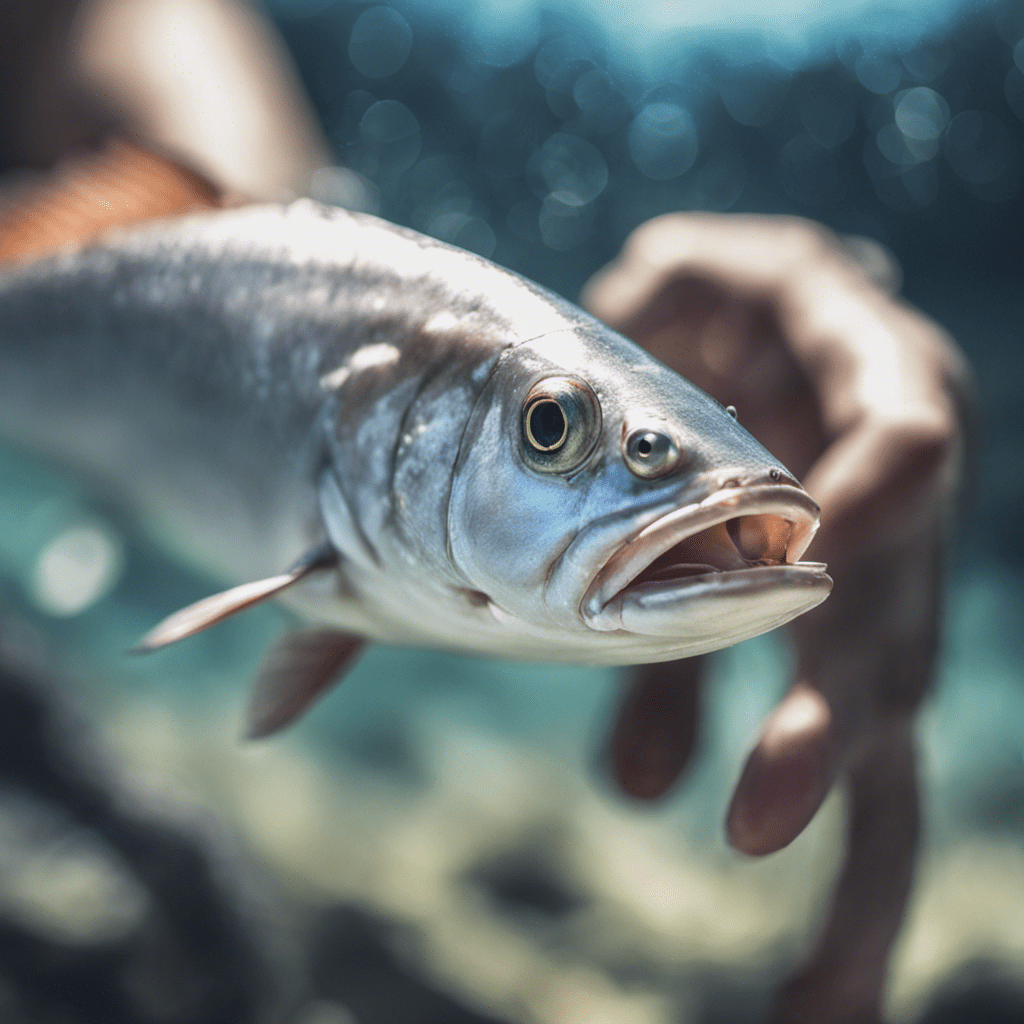
You should definitely try targeting ladyfish when you’re out on the water, as they’re known for their acrobatic jumps and silver shimmer.
Ladyfish, also known as Elops saurus, are a species of silver gamefish found in coastal waters and estuaries. They’re characterized by their elongated bodies, forked tails, and sharp teeth.
When hooked, ladyfish put on an impressive display of acrobatics, leaping out of the water in a series of flips and twists.
To successfully target ladyfish, inshore fishing techniques such as casting spoons, jigs, or live bait can be effective. Interestingly, ladyfish are often found in the same areas as tarpon, leading to the popular technique of tarpon co-targeting.
However, it’s important to note that ladyfish should be handled with care and released unharmed, as conservation efforts are in place to protect their populations and preserve their role in the ecosystem.
Black Drum: The Subtle Giant
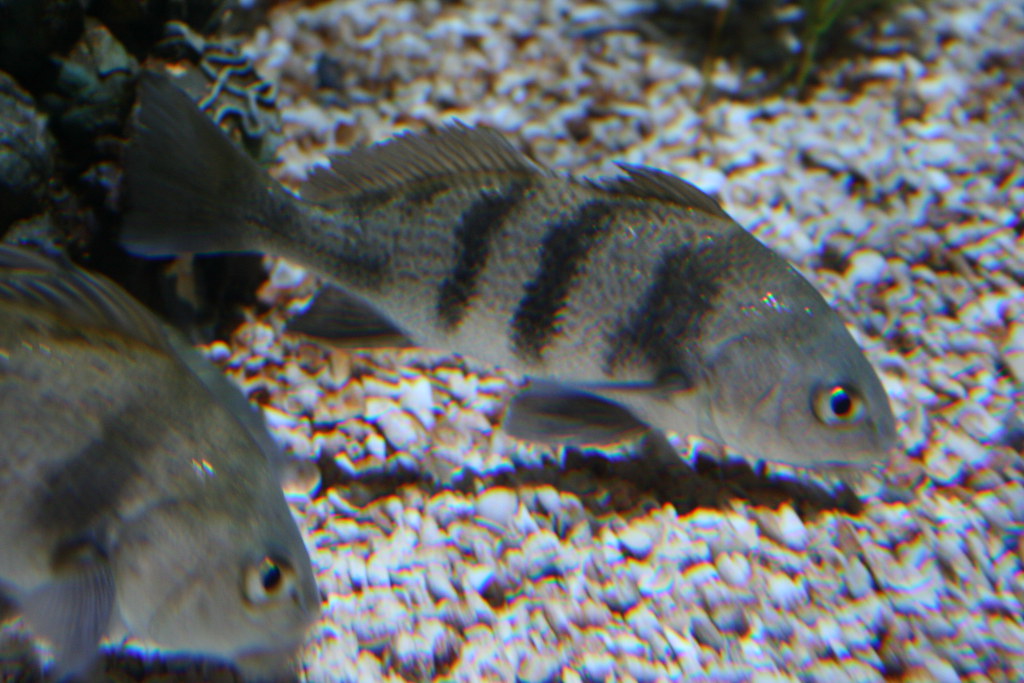
The black drum is a subtle giant, and it can be found in both saltwater and freshwater environments. This species of fish is known for its unique characteristics and behaviors. Here are three subtopic discussion ideas for understanding the black drum:
- Breeding patterns: To understand the reproductive behavior of black drum, it’s important to study their mating rituals, spawning grounds, and the factors that influence successful reproduction.
- Fishing techniques: When targeting black drum, anglers can benefit from knowing the best bait, tackle, and fishing locations. Tips for catching this elusive species include using crab or shrimp as bait and fishing near structures like jetties or docks.
- Size and weight: Black drum can grow to impressive measurements, with some individuals reaching lengths of over three feet and weighing up to 100 pounds. Knowing the average size and weight of black drum can help anglers prepare for the fight of landing one.
Understanding these aspects of black drum contributes to their conservation efforts as well as the enjoyment of anglers and culinary enthusiasts.
Mangrove Snapper: The Stealthy Biter
Don’t underestimate the skill of the mangrove snapper. It has a knack for stealthily biting the bait before you even realize it. This inshore game fish is well-known for both its delicious taste and its challenging fight. Anglers seeking an exciting fishing experience often set their sights on this prime target. The mangrove snapper, scientifically known as Lutjanus griseus, is commonly found in mangrove habitats along the coastlines of Florida, the Gulf of Mexico, and the Caribbean. With its sharp teeth and keen eyesight, this species is a master of stealthy bites, making it an exhilarating catch for anglers.
| Mangrove Snapper Facts | |
|---|---|
| Scientific Name | Lutjanus griseus |
| Average Length | 10-14 inches |
| Preferred Bait | Shrimp, small fish |
| Preferred Fishing Method | Bottom fishing |
Mangrove Snapper catch with Tarpon
As we explore the habitats where inshore game can be found, it’s important to note that while tarpon fishing, you will often come across mangrove snappers. These snappers are commonly found near mangrove structures like roots and fallen branches, where they seek shelter and prey. These habitats present plenty of opportunities for anglers to target mangrove snappers with their stealthy bites. So, if you’re looking for an exciting inshore game fishing experience, make sure to explore the mangrove habitats where these skilled biters reside.
Habitats Explored: Where to Find Your Inshore Game
Explore the diverse habitats along the coastlines to discover where your inshore game fish thrive. To increase your chances of a successful catch, consider the following factors:
- Fishing hotspots: Inshore game fish are commonly found near structures such as jetties, piers, and bridges. These areas provide shelter and food sources for the fish.
- Bait selection: Choosing the right lure is crucial for inshore fishing. Consider using live bait like shrimp or mullet, or artificial lures that mimic the fish’s natural prey.
- Weather patterns: Weather conditions can greatly influence the behavior of inshore game fish. Pay attention to wind direction, temperature changes, and barometric pressure to determine the best time to fish.
Understanding the impact of tidal movements is also important. Inshore game fish often follow the tides, feeding on the baitfish that are swept along with the currents.
Finding the perfect hiding spots for inshore game fish is key. Look for areas with submerged structures, mangroves, or grass beds, as these provide ample cover for the fish.
Transitioning to the next section about diet insights, understanding what attracts our inshore species is crucial for successful fishing ventures.
Diet Insights: What Attracts Our Inshore Species
To increase your fishing success, it’s important to consider the variety of prey options and how they attract the fish species you’re targeting. Understanding a fish’s diet is crucial for determining its feeding patterns and bait preferences.
Different fish species have different nutritional needs and foraging behaviors, which influence their choice of prey. Some species are opportunistic feeders and will consume a wide range of prey items, while others have specific preferences. Studying the feeding habits of your target species is important in choosing the most effective bait.
In addition to the fish’s diet, factors like water temperature, time of day, and season can also impact fish behavior and the availability of food. By understanding these dynamics, you can make informed decisions when selecting your bait and increase your chances of predicting when the fish will bite.
Understanding Fish Behavior: Predicting the Bite
You can increase your fishing success by studying fish behavior and predicting the bite. Understanding the patterns and habits of fish can greatly improve your fishing strategies.
Here are three key ways to predict fish behavior and increase your chances of a successful catch:
- Reading the water: Pay attention to the movement and clarity of the water. Fish tend to gather in areas with favorable conditions, such as areas with structure or where food is present.
- Observing feeding habits: Take note of what the fish are feeding on. Look for signs of feeding activity like splashing, jumping, or birds diving into the water. Matching your bait or lure to their preferred prey can greatly increase your chances of a bite.
- Noticing the weather: Fish are affected by changes in weather patterns. Pay attention to factors like wind direction, temperature, and barometric pressure. Certain weather conditions can trigger feeding behavior, while others can make fish more inactive.
Fishing Techniques: Mastering the Inshore Catch
Get ready to refine your fishing skills and become a pro at mastering the inshore catch.
Inshore fishing is a popular sport that requires specific techniques to successfully target inshore game fish. To improve your chances of a successful catch, it’s essential to understand the behavior and habits of these fish.
Start by selecting the right equipment, such as a medium-action rod and a reel with a strong drag. Mastering techniques like casting accuracy, lure selection, and retrieval speed will greatly increase your chances of hooking a prized inshore game fish.
Pay attention to the tides, as fish tend to feed more actively during certain stages. Additionally, learning to read the water and identify structures like sandbars, oyster beds, and grassy areas can help locate the best spots for fishing.
With practice and dedication, you’ll soon be reeling in impressive catches in the inshore waters.
Co-targeting with Tarpon: Two Birds, One Stone
If you want to maximize your chances of success, consider co-targeting with tarpon, as it allows you to catch two birds with one stone. Tarpon, also known as the ‘silver king,’ aren’t only a thrilling game fish to pursue, but they can also act as a beacon for other species in the area.
Here are three key reasons why co-targeting with tarpon can be beneficial:
- Targeting Techniques: Tarpon are known for their acrobatic jumps and powerful runs, so using live bait or artificial lures that mimic their natural prey can be effective in enticing them to strike.
- Bait Selection: Tarpon have a voracious appetite and are known to feed on a variety of prey, including mullet, crabs, and shrimp. Choosing the right bait that matches their preferred food source can increase your chances of success.
- Best Locations: Tarpon are often found in coastal areas, near structures such as bridges, jetties, and mangrove shorelines. These areas provide cover and attract baitfish, making them prime spots for targeting tarpon and other game fish.
Understanding tarpon behavior and incorporating these targeting techniques, bait selection, and choosing the best locations can significantly improve your chances of a successful inshore fishing trip. Now, let’s delve into the tackle and gear recommendations for inshore fishing.
Tackle and Gear Recommendations for Inshore Fishing
Before heading out on your inshore fishing trip, it’s important to have the right tackle and gear for optimal success. Here are some tackle recommendations and gear suggestions to enhance your inshore fishing experience:
| Tackle Recommendations | Gear Suggestions |
|---|---|
| Lightweight spinning rod | Polarized sunglasses |
| Medium-sized spinning reel | Hat with neck flap |
| Braided fishing line | Sunscreen (SPF 30 or higher) |
| Fluorocarbon leader line | Insect repellent |
| Assorted hooks (sizes 1/0 to 3/0) | Waterproof bag |
| Soft plastic baits | Waterproof phone case |
| Jig heads | Fishing pliers |
| Topwater lures | First aid kit |
| Crankbaits | Tackle box with compartments |
| Live bait (shrimp, mullet) | Fishing net |
These tackle and gear recommendations ensure that you are well-prepared for your inshore fishing adventure. Remember to also check the local regulations and obtain the necessary fishing licenses. Happy fishing!
Keywords: tackle recommendations, gear suggestions, inshore fishing equipment, fishing gear tips, tackle and gear advice.
Conservation Spotlight: Protecting Our Inshore Habitats
Check out the new article on ‘Conservation Spotlight: Protecting Our Inshore Habitats’ to learn how you can contribute to the preservation of our valuable inshore ecosystems. In order to protect biodiversity and ensure the sustainability of our marine resources, it’s crucial to focus on habitat restoration and sustainable fishing practices.
Here are three key ways in which community involvement can play a vital role in marine conservation efforts:
- Educating the community: By raising awareness about the importance of protecting inshore habitats and the need for sustainable fishing practices, we can foster a sense of responsibility towards our marine ecosystems.
- Promoting citizen science: Encouraging community members to participate in data collection and monitoring efforts allows for a more comprehensive understanding of the health of our inshore habitats.
- Engaging in habitat restoration projects: By actively participating in initiatives such as beach clean-ups, dune restoration, and seagrass planting, community members can directly contribute to the restoration and conservation of our inshore ecosystems.
Catch and Release: Ensuring Sustainable Fishing
Make sure you properly handle and release fish that you catch to contribute to sustainable fishing practices. Catch and release practices play a crucial role in minimizing the environmental impact of recreational angling and promoting responsible angling.
When done correctly, catch and release allows anglers to enjoy their sport while conserving fish populations for future generations. It involves techniques such as using barbless hooks, minimizing the time fish are out of water, and handling fish with wet hands or gloves to prevent damage to their protective slime coating.
Additionally, anglers should practice proper release techniques, such as gently supporting the fish in the water until it’s ready to swim away. These efforts, when combined with other conservation initiatives, contribute to the overall goals of sustainable fishing and the preservation of our aquatic ecosystems.
Local Regulations: Fishing Responsibly
You should be aware of the local regulations and fish responsibly in order to protect the fish populations and promote sustainable fishing practices. Fishing is a popular recreational activity, but it’s important to ensure that we don’t harm the environment or deplete fish populations. By following local regulations and fishing responsibly, we can contribute to conservation efforts and protect the habitats of fish species.
Here are three key ways to fish responsibly:
- Know the regulations: Familiarize yourself with the local fishing regulations, including catch limits, size limits, and seasonal restrictions. This will help you avoid overfishing and ensure that you’re fishing within sustainable limits.
- Handle fish with care: When catching and releasing fish, use proper techniques to minimize harm. Wet your hands before handling them to avoid removing their protective slime layer, which can make them more susceptible to disease. Use barbless hooks to make it easier to release fish unharmed.
- Practice catch and release: If you don’t plan to keep the fish, release it carefully and quickly. This will allow the fish to survive and reproduce, maintaining healthy populations for the future.
Seasonal Tips: Best Times for Each Species
For optimal fishing success, try targeting different species during their peak seasons, such as tarpon in the summer or snook in the fall.
Understanding seasonal patterns is crucial in identifying the best fishing spots and increasing your chances of landing a trophy catch.
When it comes to tarpon, they migrate along the coastlines during the warmer months, making them a popular target for anglers. To entice these powerful fish, live bait such as mullet or crabs is recommended. Fishing techniques like sight casting or drift fishing near bridges and passes can yield great results.
In terms of tackle recommendations, a sturdy rod, heavy line, and a strong hook are essential to handle the strength and size of tarpon.
Rewritten:
For the best fishing success, it is recommended to target different species during their peak seasons. For example, tarpon is popular in the summer while snook is popular in the fall. Understanding seasonal patterns is crucial in finding the best fishing spots and increasing your chances of catching a trophy fish.
When it comes to tarpon, they migrate along coastlines during the warmer months, making them a prime target for anglers. To attract these powerful fish, it is recommended to use live bait such as mullet or crabs. Fishing techniques like sight casting or drift fishing near bridges and passes can lead to great results.
When making tackle recommendations, it is crucial to use a robust rod, heavy line, and a strong hook capable of handling the power and size of tarpon.
Conclusion: Embracing the Inshore Experience
To truly embrace the inshore experience, don’t hesitate to try out different fishing techniques and explore various hotspots along the coastlines. Here are three key elements to consider when venturing on your inshore adventure:
- Fishing Techniques: Experiment with baitcasting, spinning, and fly fishing to maximize your chances of success. Each technique has its own advantages and can be tailored to specific conditions and target species.
- Conservation Efforts: As an angler, it’s crucial to prioritize the conservation of our marine resources. Follow size and bag limits, practice catch and release, and be mindful of sensitive habitats to ensure the sustainability of inshore fisheries for future generations.
- Seasonal Strategies: Stay informed about seasonal patterns and adapt your fishing strategies accordingly. Different species have specific migration and feeding habits, so understanding when and where they’re most active will greatly enhance your inshore experience.
Further Reading: Dive Deeper into Inshore Fishing
Check out these recommended books and articles for a more in-depth understanding of inshore fishing techniques and strategies.
If you want to look deeper into the world of inshore fishing and learn more about prime game fish, particularly the majestic tarpon, there are several resources worth exploring.
For a comprehensive guide on inshore fishing, ‘The Inshore Angler’s Handbook’ by Lou Tabory provides valuable insights and practical tips.
Another great read is ‘Inshore Fishing: A Complete Guide’ by Peter Kaminsky, which covers various inshore species and their behavior.
If you’re interested specifically in tarpon fishing, ‘Tarpon on Fly: A Guide to Catching the Silver King’ by Tom Rowland is a must-read.
These resources will enhance your knowledge and equip you with the necessary skills to tackle inshore fishing and target prime game fish like the tarpon.
Happy reading and tight lines!
Frequently Asked Questions
What Are the Best Times of Year to Target Redfish in Inshore Waters?
The best times to target redfish in inshore waters are during the spring and fall. Use lures like spoons and soft plastics, or try bait options like shrimp and mullet. Look for prime locations like oyster bars and grass flats. Take advantage of calm, sunny days for the most success.
How Can I Attract Snook to Bite in Coastal Areas?
To attract snook in coastal areas, use bait that mimics their natural prey like shrimp or small fish. Look for snook fishing spots with structure or areas where they like to ambush prey. Use appropriate fishing techniques and gear for snook.
What Are Some Effective Fishing Techniques for Catching Speckled Trout in Estuaries?
To catch speckled trout in estuaries, try these estuary fishing tips. Target the trout in shallow water by selecting lures that mimic their prey. Look for trout in estuaries where there is a mix of saltwater and freshwater.
What Type of Gear and Tackle Is Recommended for Targeting Jack Crevalle?
To target jack crevalle, you’ll need the right gear and tackle. Look for a heavy rod and reel combo, sturdy line, and strong hooks. Choose bait like live mullet or topwater lures. Scout for their preferred locations and maintain your tackle for optimal performance.
Are There Any Local Regulations or Restrictions on Fishing for Black Drum in Inshore Habitats?
Local regulations and fishing restrictions may vary in different inshore habitats when targeting black drum. It is important to check for any specific rules before fishing. The best times to target redfish, attract snook, and catch speckled trout in inshore waters are during the early morning and evening. Effective fishing techniques include using live or cut bait, such as crabs or shrimp, and fishing near structures like docks or mangroves. Estuaries and coastal areas are known to be productive for black drum fishing. Recommended gear and tackle for targeting black drum in inshore habitats include medium to heavy spinning rods, braided fishing line, and circle hooks. Additionally, it is recommended to use a leader with a weight or sinker to keep the bait on the bottom where black drum are often found.
Conclusion
As the sun sets on a day of inshore game fishing, the thrill of the chase lingers in the air. The marshes and coastlines come alive with the vibrant colors of redfish, snook, speckled trout, and jack crevalle. These powerful and elusive creatures captivate anglers with their strength and cunning.
By embracing the inshore experience, you immerse yourself in a world of excitement and adventure, where the beauty of nature and the thrill of the catch converge. Look deeper into the art of inshore fishing and unlock a world of endless possibilities.

